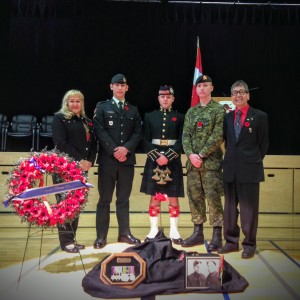
Aboriginal Veteran’s Story is Centre Stage at Waterdown High
By Rob Faulkner, HWDSB
Edison Kahgee focused on the positive.
“Don’t worry about something that hasn’t happened yet, we have enough other things to worry about,” he’d say. Or, “let go of the bad things in life and think about what’s good,” he’d tell family. He was the kind of quiet grandfather who kept his opinions on parenting to himself, but when his daughter showed attitude he slipped three lemons into her school lunch.
Not that Kahgee didn’t have reason to be mad. An Aboriginal veteran of the Second World War, he didn’t get the medals, the money or the hero’s welcome given to white veterans. He lost his status, as an Ojibway of the Saugeen First Nation, for serving. He could die for Canada, but not vote in Canada until 1960.
His was one of many stories shared in schools on Remembrance Day, as students and staff gathered for moving assemblies with veterans, music, recitations of In Flanders Fields and more. WDHS was one of several schools to focus on Aboriginal contributions; it’s estimated 7,000 First Nations people served in the two world wars and Korea.
At Waterdown District High School (WDHS), the story of Edison Kahgee had a personal connection – Kahgee’s son, Eugene, is a construction teacher at the school. Eugene and his wife Cindy were part of the platform party at the school ceremony. Cindy shared Edison’s story because Eugene finds the emotions hard to handle.
“He never talked about the war,” said Cindy. “When he came to live with us, he was quiet and taught by example.” Adds Eugene: “I always respected him… And when I wanted to serve in the military like he did, he told me it really wasn’t the place for me because I didn’t like following orders.”
Waterdown history teacher and author Nathan Tidridge led the assembly from the stage, introducing a variety of speakers.
Principal Michelle Visca said Kahgee’s story matters, as do the stories that can be found in every family. Many Waterdown families are contributing stories and artifacts to the school museum. And the history of service stretches all the way to the Main Office. Vice-Principal Dan Stepaniuk, a Lieutenant-Colonel in the Royal Hamilton Light Infantry, has been on leave since April serving with the military overseas.
At the ceremony, a light shone on a special display that included one of the ceramic poppies from the Tower of London art installation, as well as a unformed photo of Edison and his brother Alvin, Edison’s medals, Aboriginal artifacts and a wreath that HWDSB Trustee Penny Deathe laid with Waterdown graduates, Privates Matthew Davidson and Colin Rose of the Royal Hamilton Light Infantry and Matthew Sheridan of the Argyll and Sutherland Highlanders of Canada.
Before students circled the Kahgee display, Tidridge explained Kahgee’s return after the war. He had served alongside Canadians, even after being forced to attend the Mohawk Institute residential school where he was whipped daily.
Returning soldiers could receive up to $20,000 after the war, Tidridge said, as long as they weren’t black or Aboriginal. It took until 2004 for Kahgee’s funds to arrive, three years after his death. His medal for Aboriginal military service arrived a bit earlier, but still after his death.
“We live in the greatest country in the world, and Edison would have said that,” Tidridge told students. “But it’s not perfect. It falls to you, to us, to help this country realize its full potential.”
Updated on Wednesday, November 11, 2015.


